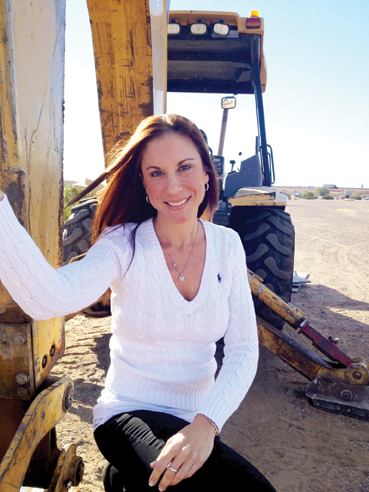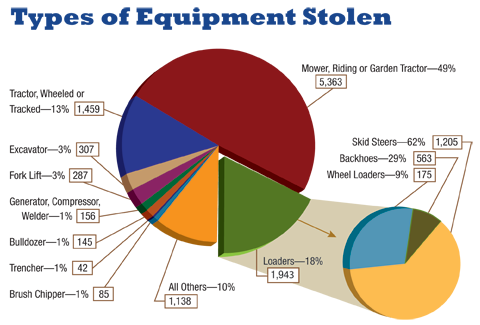Business Management
Thieves Covet What You Own
. . . and it's relatively easy to steal
By Mike Martin
The National Insurance Crime Bureau in a 2011 review pegged the cost of equipment and tool theft at a billion dollars per year. What do the thieves target? Frankly, just about anything you rent a contractor. Why? Because stealing your equipment is relatively easy and it can be lucrative.
Although the trend is good - the National Crime Information Center (NCIC) says heavy equipment theft dropped from 17,638 units in 2005 to 10,925 pieces stolen 2012, the last year for which the data is available. But that’s still nearly 11,000 pieces that disappear from job sites, rental yards and in-transit annually. Plus, as a percentage of the equipment being stolen, rental centers are more frequently at risk because, explains Courtney DeMilio, associate vice president of LoJack Commercial Division, the equipment-stealing business “has evolved. It had been more balanced between contractors and rental. But from about 2010 on, we’ve seen increasing theft problems in rental (fleets).”
No national data is captured to show if stolen machinery was owned by a rental center. However, DeMilio’s data comes from the company’s customer base, so they know exactly who owned it. Their data also includes more than heavy equipment, which is what the NCIC reports.
Thieves have shifted to rented equipment in part, she says, because contractors tend to rent rather than buy right now, so rental
 |
| Courtney DeMilio, LoJack Commercial Division |
fleets have been growing. Plus, equipment demand has increased with the uptick in construction and the increase in natural disasters. Natural disasters drive clean-up and rebuilding efforts, which require a lot of equipment. “Equipment goes where it is needed and thieves go where the equipment goes,” DeMilio adds.
Target-rich environment
What is stolen? “Just about anything on a job site,” she comments. “Light utility trucks, trailers, generators, light towers and compressors are often targeted. The more versatile equipment – minis, backhoes, loaders, skid steers – it’s all being stolen. This is why equipment owners are desperate for solutions.”
LoJack sells a covertly-placed radio device that emits a radio signal and can be tracked by equipment they donate to police departments. Trained dealers or LoJack staff install the device, sold with a one-time fee upfront. Installation typically occurs when a new or used piece of equipment is sold, but it can be added at any time. DeMilio says more than 250,000 pieces of heavy equipment are rolling around with the device and “if you include trucks and trailers, it would be a staggering number,” she says.
When a customer reports a loss, the company activates the device and law enforcement searches for the radio signal. Along with the equipment donated to law enforcement to find the radio signals, LoJack provides training on its use.
Recovery rate with the device is good – and often fast. Their data shows about 43 percent of equipment is recovered in five hours or less, 68 percent in less than 24 hours.
That’s good news for you as an owner, but even with full recovery there’s a cost to you with potential increase in insurance rates, and a cost to your customers.
“There’s a litany of problems that can impact a rental center’s customers,” DeMilio points out. “And if it’s a small business, they can really take a hit. If their main piece of equipment is stolen, it shuts down a whole site. You can have crews and other equipment sitting idle for hours or longer. It threatens the contractor’s ability to get the job done on time and on budget. Profit drops with any delay.”
While every job site or rental yard is a potential target, most thefts occur because the equipment “is relatively easy to steal,” she adds. Construction equipment is in high demand for theft – yet cabs are open, keys may be universal, registration or titling are not required and, “it’s very predictable that the more vulnerable areas, less protected areas, will see more theft.”
Registration can help
 |
| Ryan Shepherd, National Equipment Register |
One of the main efforts of National Equipment Register, says Ryan Shepherd, the organization’s general manager, is to address the registration issue; NER builds and manages a custom database of registered equipment. The database helps establish and track “the chain of equipment ownership.”
Autos, with their required VIN registration, show a chain of ownership and VINs are used to accurately identify stolen vehicles. With no DOT requirement for heavy equipment registration, it’s tough to track ownership. NER’s database system, which includes make, model, serial number, paint schemes and any owner-applied numbers or other identification, puts customers’ fleet data into a proprietary national database, which is accessed by law enforcement.
Shepherd describes two scenarios where this plays a role. In one, you or one of your customers show up at work early Monday morning and notice a gap where a backhoe was supposed to be. A quick call determines that no one picked it up for service, so you contact NER, which alerts law enforcement and provides identification details.
Similarly, if a state trooper or other officer wonders why a piece of equipment is on the road at 2 a.m. or on a weekend and has reason to stop the driver and ask questions, they can contact NER. NER helps law enforcement find the serial number. If it’s registered, they contact the owner to see if it is missing or if it was on a legitimate mission to get to the next project.
“When all of the registration information is readily available and there’s a potential incident, there is less for the owner to worry about and more information for law enforcement to be able to take action. If it is a theft, we support the law enforcement efforts and fully focus on location and recovery,” Shepherd says, “so that the rental center or contractor can focus on running their business.”
NER charges a fee to register equipment, although ARA members can register up to 1,000 pieces of equipment at no charge. It provides decals so you can tag your equipment and let potential thieves know that it is registered and, therefore, traceable.
NER also offers a telematics system typically used for locating equipment. The system is owner-applied. “We can recommend placement for better concealment as well as signal to the sky,” Shepherd explains. Once every six hours the GPS “turns on to report in. This takes 30 seconds to a minute. So if someone wanted to ‘sweep’ the equipment to see if it had a device, it’s much more likely to be sleeping.” The device has its own battery, recharges off the machine’s battery when it’s running, and will self-initiate a trickle charge from the machine if the device battery level drops below 20 percent.
Owners can log in to see when the GPS was last triggered, identify its location and make sure it is where it is supposed to be. If equipment appears to be stolen, the unit is triggered and pings full time to aid recovery. If a thief is aware of the device, it can be disabled. Still, there’s greater likelihood of knowing where the equipment was as early as one minute or as late as five hours 59 minutes from when it provided its automatic location “ping.”
The recovery rate of all stolen equipment, Shepherd says, is about 20 percent, a great improvement over the five percent rate from a couple of decades ago. He recommends benchmarking against autos, though. “Autos have a 70 percent recovery rate. So, while 20 percent is a vast improvement, it still means eight out of 10 pieces of equipment aren’t found.”
The telematics systems on newer equipment also offer recovery capabilty. Joe Mastanduno is account manager, rental industry,
 |
| Joe Mastanudo, John Deere Construction & Forestry |
for John Deere Construction and Forestry. The company’s PowerSight telematics system is standard on its backhoes and larger equipment. About half of this equipment goes to rental – including Deere dealerships, national accounts and independent rental centers. There are four versions – Ultimate, Select, Express and Locate - all of which include curfew creation, location and geofencing.
The Ultimate version lets owners monitor how a piece of equipment is being used and offers additional value to rental centers because “this data tells you if it was being used in compliance with the rental agreement,” he explains. Select and Express
versions deliver less data, but still include engine hours, distance traveled, maintenance alerts.
“Locate” supports only curfew creation, geofencing and location. Curfew creation lets you set the times the machine should be inactive. If the machine starts or moves after curfew, you receive an alert via iOS or Android, email or text. Geofencing lets you create a GPS-coordinates or map box around a job site or lot, for example. If the machine moves beyond the geofence, you receive an alert. The Locate version calls in every 12 hours so curfew and geofence may be delayed; it’s not real-time.
“Geofencing and location use an in-house designed GPS device,” Mastanduno says. “It has its own battery to operate even if the machine is not. It’s also installed to be more difficult to find.”
Can it be disabled? “You’d have to be very clever. Even if you can figure out where the device is, you’d have to know electronics to be able to shut it down.”
To locate a machiine, you log into a secure service or contact John Deere for their help, then let law enforcement take care of the rest. These tools could be helping. It looks like last year’s thefts were down from 2012. “We haven’t finalized our data on last year’s numbers but, based on feedback from our members, the amount stolen compared to the previous year is static – maybe a couple hundred units lower,” Shepherd comments.
He attributes part of this to the recession. “Compared to the boom years, there became and is now an increased sense of risk management. Owners had to tighten up all aspects of their business. With the change in (economic) momentum, they had to increase steps to prevent anything that could hurt their business, including thefts,” Shepherd says.
Still, with about 30 pieces of heavy equipment missing every day, there’s room to improve. Where can you focus your efforts?
Consider location. The 2012 Equipment Theft Report (find it on NER’s website) shows that more than half of all equipment reported stolen is from “Other’s Premises” because a job site has lower levels of physical security than your rental yard or service areas. About 35 percent is stolen from the “Insured’s Premises,” which suggests a review of the security practices on your lots is in order.

The remaining percentage is stolen while in transit. Thieves, the report notes, look at value and mobility. While dozers have high value, they’re tougher to move, which is why “only” 145 were stolen in 2011. Though lower in value but easier to steal, more than 1,400 wheeled or tracked tractors were stolen, and more than 1,200 skid steer loaders. Landscaping equipment, mainly commercial riding mowers, topped the list with more than 5,360 units taken.
Consider equipment age. Thieves apply the same value equation most of us would when “shopping” for used equipment – newer models are worth more. And more often targeted for illicit removal from your lot or customers’ job sites. The 2012 data shows that 36 percent of the equipment stolen was from 2012 or two previous model years; nearly half of the equipment stolen was five or fewer model years old.
What other steps can you take? Fence equipment whenever possible, use parking strategies that keep easier-to-steal, lighter equipment inside a circle of heavy equipment. Or park equipment in a row so it’s easier to spot something being moved. Chain smaller equipment together, light the job site at night, use ignition locks or other systems to help immobilize equipment until you or your customers don’t want it immobilized.
And consider your “circle of trust.” There’s value in being secretive about any anti-theft system you use. Not everyone needs to know how the NER or JDLink devices operate or where they’re located. If you installed a LoJack system, DeMilio says, “don’t tell people it’s there. The element of surprise is important.”
Why? Because in many instances, the theft may be an inside job. “We don’t track those statistics separately, but I can tell you that in my work with customers that have multi-million dollar fleets, I see it frequently.”
Concentrated, local
Based on LoJack’s data, theft occurs more frequently where there are a lot of construction projects near borders or major shipping ports. The top states, in order, are: California, Texas, Florida, Georgia, New Jersey, North Carolina, Arizona, Maryland, Ohio, Colorado, Illinois and New York.
Ninety-five percent is recovered in the state in which the theft was reported and was either in storage or in use on a local job site.
Newer equipment has higher resale value; in 2013, 46 percent of the equipment stolen (remember that LoJack’s data covers a broader range of equipment and vehicles) was less than five years old.
This data is derived by tracking theft reports in 27 states where equipment outfitted with a LoJack system led to recovery. The company says the scope of its research doesn’t paint a complete picture, but can illustrate trends.
If you’d like to look at more statistics, you can find the “2012 Equipment Theft Report” on the NER’s website: www.ner.net/annual-theft-report.html and on www.nicb.org.









